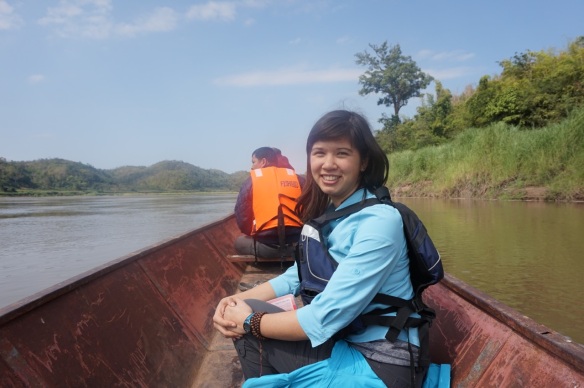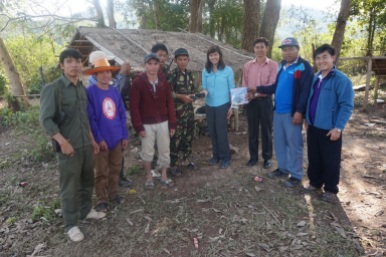
Finally visiting a Fish Conservation Zone in Laos!
As our boat rounded a bend in the river among the hills, I asked my colleague Sinsamout, “Are we near the halfway point?” We were touring a 5-km-long Fish Conservation Zone, or FCZ, on the Mekong River in an area in Laos called Kengmai Rapids. My company has helped four villages designate this FCZ as a no-fishing area to protect an endangered fish species. Sinsamout said, “Yes, it’s just past the curve.” My heart leapt – yes, I realized, I knew that curve in the river. Over the past year, I had seen a map of the FCZ on the regulation signs we designed – I saw how it partially wrapped around two bends in the river. Now, after more than two years of supporting this project from the office – helping to write the grants, manage the budget, and report to the donor – I was finally seeing a Fish Conservation Zone in Laos for the first time.
After overcoming our transportation challenges, we had visited the village of Ban Palat, where we had a meeting with members of the Fish Conservation Zone committee. We met in their village temple, under the gaze of a shiny golden Buddha. Each of the four villages around the FCZ has an enforcement team, and they rotate patrolling duties of the FCZ to make sure no one is fishing in the closed area. We talked about their experiences of patrolling and enforcing the regulations. After the meeting, our team traveled to the river, where we met the enforcement team from Houayla, the village across the river in Xayabouri Province. We ate lunch and I tossed bits of meat and rice to a pair of desperately skinny dogs that scrounged in the trash nearby.

Fish Conservation Zone on the Mekong River
Then we piled into a long boat for our tour of the river. Despite rain that morning, the sun was out and the sky was blue. The rapids, for which the Kengmai Rapids region gets its name, were mostly submerged, but I could see how the water rushed and swirled a bit faster in the middle of the river. Being on the river felt so good, to finally connect with the work I’ve been doing from afar. Leafy trees grew in the water, all but submerged along the banks of the river, which are steep and hilly. Near the center of the FCZ, we climbed out and scrambled up the hillside to visit a farmhouse near the edge of the river. I at last got to see the signs of the Fish Conservation Zones that I had helped design.
An old woman sat chewing betel as she harvested white roots, which I was offered to sample. It tasted a bit like a watery radish, but slightly sweet instead of spicy. As we walked to the farmhouse, little chicks and ducklings skittered across the dirt. I saw seedpods from a nearby tree that were cracked open to reveal insides that looked like cotton or dandelion down. Sinsamout it can be used to stuff pillows or mats. A young man sat cutting bamboo pieces to make a roof for a chicken house. Both he and the old woman told us that since the Fish Conservation Zone was put into effect, they don’t hear people using dynamite to fish in the river at night anymore – it’s very quiet. The woman said she used to fish right near their farm, but now she has to travel outside the boundaries of the FCZ, which is hard at old age. But she said she still thought the FCZ was a good idea to protect fish for future generations.

In the side channel beside a sandbar
We traveled back down the river, and explored a side channel that becomes an isolated pool cut off from the main river during the dry season. The villagers have discussed wanting to open this pool up for a community fishing day to raise money for their FCZ enforcement activities. Small birds with swallow wings skimmed across the water, and a white egret flew past. Two small boys played with sticks along the sandbar, the only other people we could see for miles. As we motored away, the boys began to run along the sand, and cinematic movie music swelled in my head.
Further downstream, past the boundary of the FCZ, we came across a fishing camp. The fishers hadn’t caught much that day – one showed us a fish trap with a few flopping silvery fishes in it. We looked at their nets, and Sinsamout said he had photographed one of the fishers a few years ago on a previous trip to the area. I distinctly remember those photos, and it felt like pieces coming together to finally see this familiar fishing camp for myself. We ended our trip by handing over some binoculars to the enforcement team that I had brought from the U.S. Several of the enforcement team members are village soldiers or police officers, and they looked very official testing out the binoculars with their camouflage uniforms and rifles.

At last I got to see a Fish Conservation Zone sign I helped design!
The specter hanging over this idyllic river scene is that the site of a proposed dam on the Mekong River is just downstream of our project site. If constructed, it would likely turn our project area into a reservoir, flooding the shallow spawning habitat that many native fish need. Sometime it’s hard to work in the midst of such uncertainty. At least now I can carry with me the memory of those two boys running along the sand.

















What a sense of accomplishment to finally see the FCZ you helped create! The comment by the old woman about the importance of FCZ for younger generations even though it’s a hardship for her, is a testament to the success of outreach efforts to educate the community. Keep up the good work in spite of uncertainties. I am very proud of you and look forward to reading more about your experiences on this journey!
Love and hugs from Mom
PS: the white root you tasted looks like jicama
Hi Erin. I can feel your excitement in reaching the FCZ that you had previously only seen on maps. And there, too, was the sign that you helped design! Amazing how it all came together! Enjoyed your photos and video. Love that first photo of the trees and reflections in the water. Not sure how you got the effect of the black background, but it’s beautiful. Thank you for sharing.
Love, Grandma
Pingback: Off the grid | Erin Loury